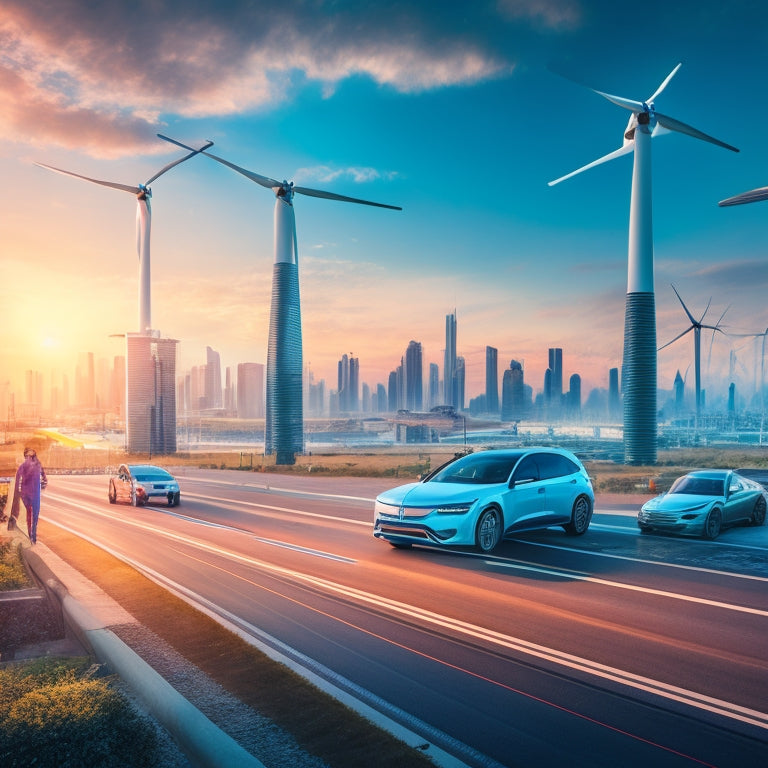
Global Electric Vehicle Market: Technology and Trends
Share
The global electric vehicle market is poised for rapid growth, projected to surge from USD 578.71 billion in 2024 to USD 2071.02 billion by 2032, driven by increasing fuel prices, government initiatives, and global expansion of electric car manufacturers. The market is segmented into battery-electric transportation, plug-in hybrid EVs, and fuel-cell EVs, with battery technology advancements improving driving range and reducing costs. As environmental concerns and emissions regulations drive EV adoption, future growth is expected to be driven by innovations in battery technology and charging infrastructure, ultimately shaping the future of sustainable transportation.
Key Takeaways
• The global electric vehicle market is projected to surge from USD 578.71 billion in 2024 to USD 2071.02 billion by 2032, driven by increasing fuel prices and government initiatives.
• Battery electric transportation dominates the market, with advancements in battery technology improving driving range and reducing costs.
• Rising environmental concerns and stringent emissions regulations drive EV adoption, with ambitious targets set for electrification of transportation sectors.
• The market is driven by innovations in battery technology and charging infrastructure, with consumer preferences shifting towards sustainable transportation options.
• Intense competition among major players like Tesla, Daimler AG, and Nissan shapes the market, with strategic acquisitions, partnerships, and innovative product offerings driving market share.
Electric Vehicle Market Overview
The global electric vehicle (EV) market is poised for significant growth, projected to surge from USD 578.71 billion in 2024 to USD 2071.02 billion by 2032, registering a compound annual growth rate (CAGR) of 17.27% during the forecast period.
This remarkable growth is driven by key drivers such as increasing fuel prices, government initiatives, and the global expansion of electric car manufacturers. Additionally, emerging economies present lucrative opportunities for the EV market.
However, high EV prices and underdeveloped aftermarket services are factors restricting growth. As the market continues to evolve, it is essential to address these challenges and capitalize on the opportunities presented by emerging economies to drive growth and adoption.
Technology Segmentation Analysis
Electric vehicle market technology segmentation categorizes the industry into battery-electric transportation, plug-in hybrid EVs, and fuel-cell EVs, with battery electric transportation dominating the market in 2022. This segmentation highlights the importance of battery technology in the EV market.
Battery Technology Advancements: Improvements in battery technology have increased the driving range and reduced the cost of EVs, making them more competitive with internal combustion engine vehicles.
Charging Infrastructure Development: The expansion of charging infrastructure has addressed range anxiety, making long-distance travel possible and increasing EV adoption.
Diversification of EV Types: The market offers a range of EV types, including passenger cars, buses, and trucks, catering to diverse consumer needs.
Government Incentives: Governments worldwide offer incentives, such as tax credits and subsidies, to encourage EV adoption and reduce greenhouse gas emissions.
Market Trends and Insights
Rising environmental concerns and stringent emissions regulations are driving the adoption of electric vehicles, with many countries setting ambitious targets for electrification of their transportation sectors.
As a result, the electric vehicle market is poised for significant growth, driven by future innovations in battery technology and charging infrastructure. Consumer preferences are also shifting, with increasing demand for sustainable and environmentally friendly transportation options.
The market is expected to be shaped by these trends, with manufacturers responding to changing consumer preferences and investing in research and development to stay ahead of the competition. As the market continues to evolve, we can expect to see new and innovative solutions emerge, further accelerating the adoption of electric vehicles.
Regional Market Performance
Across various geographic regions, the electric vehicle market exhibits diverse growth patterns, with Asia Pacific dominating the market share in 2022. This region's dominance can be attributed to government initiatives, increasing fuel prices, and the global expansion of electric car manufacturers.
Regional growth in Asia Pacific is driven by countries like China, Japan, and South Korea, which aim to become top EV producers by 2030.
The market dynamics in Europe are influenced by the presence of established automotive companies and stringent emission regulations.
The North American market is driven by the presence of key players like Tesla and Ford.
Emerging economies like India offer lucrative opportunities for EV market growth.
Understanding regional market performance is essential for identifying opportunities and challenges in the electric vehicle market.
Competitive Landscape Analysis
The competitive landscape of the electric vehicle market is characterized by intense competition, with major players like Tesla, Daimler AG, and Nissan vying for market share through strategic acquisitions, partnerships, and innovative product offerings.
Tesla's dominance in the market is evident, with its aggressive manufacturing and market expansion strategies. However, emerging players are also making their presence felt, disrupting the traditional automotive industry.
The market is consolidated due to increasing competition, acquisitions, and mergers. Key companies like Daimler AG, Nissan Motor Corporation, Toyota Motor Corporation, Ford Motor Company, and BMW are also making significant investments in electric vehicle technology to stay competitive.
As the market continues to evolve, we can expect to see new players emerge and existing ones adapt to the changing landscape.
Frequently Asked Questions
What Are the Environmental Benefits of Switching to Electric Vehicles?
Transitioning to electric vehicles notably decreases environmental impact by minimizing air pollution, improving air quality, and decreasing carbon footprint, ultimately contributing to a cleaner and healthier environment.
How Does the Cost of Owning an EV Compare to a Traditional Gas-Powered Car?
"Break a leg" with electric vehicles, which often "penny-pinch" with lower operating costs, largely due to superior fuel efficiency, making them a cost-effective alternative to traditional gas-powered cars in the long run.
What Is the Average Lifespan of an Electric Vehicle's Battery?
The average lifespan of an electric vehicle's battery is around 10-15 years, with battery degradation occurring over time due to charging cycles, impacting range and overall performance.
Can Electric Vehicles Be Charged Using Renewable Energy Sources?
Electric vehicles can be charged using renewable energy sources, leveraging renewable infrastructure and energy storage solutions to reduce greenhouse gas emissions and promote sustainable transportation.
Are There Any Government Incentives for Buying an Electric Vehicle?
Government incentives for buying electric vehicles include federal tax credits of up to $7,500 and state rebates, varying by state, to encourage adoption and reduce emissions, making EVs a more affordable and attractive option.
Related Posts
-

Why Merge Earth's Heat With Sun's Energy?
You're about to utilize the full potential of renewable energy by combining the Earth's natural heat with the Sun's a...
-

7 Solar-Safe Window Solutions for Earth-Conscious Homeowners
As an earth-conscious homeowner, you're likely keen to find solar-safe window solutions that align with your values. ...
-

Green Deck Options: Earth-Conscious Choices for Your Home
You're looking for a deck that not only enhances your home's exterior but also aligns with your eco-friendly values. ...


